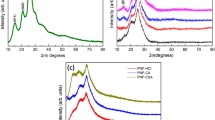Abstract
Supramolecular structures (domains, associates, nanoparticles) based on conjugated polymers are attractive basis for creating new materials for use in modern electronics. In this work we propose a mechanochemical method of synthesis of electrochemically active aniline- and N-(2-hydroxyethyl)aniline-based polymers. The effect of hydroxyethyl moieties on self-assembly of nanoparticles has been studied. Methods of dynamic light scattering and transmission electron microscopy have shown formation of nanosized particles of polyaniline and submicron particles of poly[(N-2-hydroxyethyl)aniline]. The electrical properties of materials were investigated: conductivity of polyaniline is 0.14 Sm/cm, which is constant over a wide range of temperatures and frequencies; conductivity of poly[(N-2-hydroxyethyl)aniline] is in range 2 × 10–9–1 × 10–6 Sm/cm, which strongly depends on temperature and alternating current frequency.



Similar content being viewed by others
REFERENCES
W. A. Muñoz, S. K. Singh, J. F. Franco-Gonzalez, M. Linares, X. Crispin, and I. V. Zozoulenko, Phys. Rev. B 94, 205202 (2016).
L. Lu, T. Zheng, Q. Wu, A. M. Schneider, D. Zhao, and L. Yu, Chem. Rev. 115, 12666 (2015).
R. L. Zaffino, T. Galan, W. A. Pardo, M. Mir, and J. Samitier, Wiley Interdiscip. Rev. Nanomed. Nanobiotechnol. 7, 817 (2015).
S. K. Dhawan, A. Kumar, H. Bhandari, B. M. S. Bisht, and F. Khatoon, J. Polym. Sci. 5 (1A), 7 (2015).
M. A. Soto-Oviedo, O. A. Araújo, R. Faez, M. C. Re-zende, and M. A. de Paoli, Synth. Met. 156, 1249 (2006).
O. Bubnova, Z. U. Khan, H. Wang, S. Braun, D. R. Evans, M. Fabretto, and S. Desbief, Nat. Mater. 13, 190 (2014).
L. Feng, C. Zhu, H. Yuan, L. Liu, F. Lv, and S. Wang, Chem. Soc. Rev. 42, 6620 (2013).
C. Tang, N. Chen, and X. Hu, in Conducting Polymer Hybrids (Springer Int., Cham, Switzerland, 2017), p. 1.
Y. Shi, L. Peng, Y. Ding, Y. Zhao, and G. Yu, Chem. Soc. Rev. 44, 6684 (2015).
S. Bhadra, D. Khastgir, N. K. Singha, and J. H. Lee, Prog. Polym. Sci. 34, 783 (2009).
J. Huang, Pure Appl. Chem. 78, 15 (2006).
J. C. García-Gallegos, Y. I. Vega-Cantú, and F. J. Rodríguez-Macías, J. Mater. Res. 33, 1486 (2018).
Funding
The work is performed according to the Russian Government Program of Competitive Growth of Kazan Federal University.
Author information
Authors and Affiliations
Corresponding author
Ethics declarations
The authors declare no competing interests.
Rights and permissions
About this article
Cite this article
Khadieva, A.I., Gorbachuk, V.V., Latypov, R.R. et al. Synthesis and Comparison of the Electrical Properties of Polyaniline and Poly[(N-2-hydroxyethyl)aniline]. Semiconductors 53, 2090–2093 (2019). https://doi.org/10.1134/S1063782619120133
Received:
Revised:
Accepted:
Published:
Issue Date:
DOI: https://doi.org/10.1134/S1063782619120133



